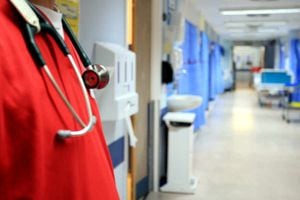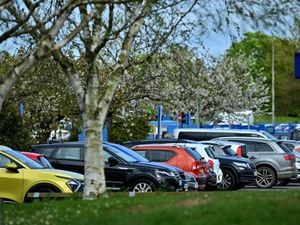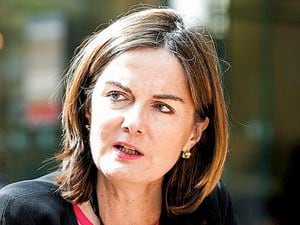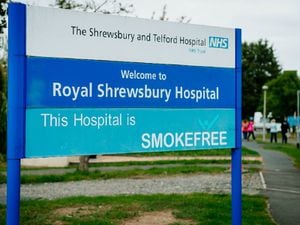Future Fit Q&A: 20 questions answered on the future of NHS in Shropshire
Labour politicians from Shropshire and Montgomeryshire have posed 20 questions to Shropshire and Telford & Wrekin Clinical Commissioning Groups about the Future Fit review of hospitals.

Today the Shropshire Star publishes those questions – and the answers given by NHS bosses.
The responses have been provided by David Evans, chief officer at Telford & Wrekin CCG, and Dr Simon Freeman, accountable officer for Shropshire CCG.
Q The CCGs’ summary consultation document suggests the public has made clear that two of its six priorities are that ‘NHS services should be more joined up’ and that the NHS should ‘try to care for me at home, even when I am ill’. The original Future Fit plan promised an integrated ‘whole system transformation’ of our local health and social care services. Why has this approach been abandoned? How can plans for the radical reform of hospital services proceed in isolation from improvements to local GP, social care, community and public health services?
A Shropshire, Telford & Wrekin Sustainability and Transformation Partnership (STP) includes all partners from across health and social care, as well as the voluntary sector and patient groups.
Together, we continue to work to drive system improvements and have identified a number of local priorities. These include Shropshire’s Care Closer to Home Programme, Telford & Wrekin’s Neighbourhood Programme and Future Fit, as well as other priorities which include primary care, frailty, mental health and cancer.
None of these delivery programmes work in isolation of each other as many have interdependencies which require close working arrangements and collaboration. They are also aligned to other work programmes, including strategic workforce developments, digital enablement and estates, and together they are working to deliver system transformation. Progress is captured and reported bi-monthly through the system governance framework with system leaders including NHS England and NHS Improvement.
Q The CCGs concede that ‘any option we choose would mean that some people would have to travel further for their emergency care or planned care’. In many urgent cases, there is a direct correlation between the time it takes to access emergency care and survival rates. Your letter categorically states that ‘there is absolutely no evidence that these procedures place either patients, or staff, at risk’. Can you guarantee that greater distances to the emergency centres at either the Royal Shrewsbury Hospital or Princess Royal Hospital and/or the additional time taken to refer a patient from an urgent care centre to the emergency care site will never in any circumstances jeopardise care or, in the most serious cases, survival?
A National evidence tells us that in an emergency, such as a heart attack or stroke, getting patients to the right hospital to receive the right treatment leads to better outcomes.
Paramedics routinely diagnose patients in an ambulance to make sure that a patient is taken to the right hospital for the most advanced treatment. This often means that a patient will travel further and may drive past an A&E department to get them to the right place. This is happening now as ambulances take patients from across Shropshire, Telford & Wrekin and Mid Wales who have had a stroke and need specialist care to the stroke unit at the Princess Royal Hospital.
Similarly, patients who need heart or lung surgery are taken out of county to Stoke-on-Trent. Both the West Midlands and Welsh ambulance services have been involved in the Future Fit process and support the delivery of this public consultation. We are continuing to have detailed discussions with them around developing detailed pathways and ensuring the best possible care for our patients. The CCGs have also commissioned a specific ambulance modelling activity exercise to explore the potential impact of the proposed acute hospital reconfiguration on ambulance/patient transport activity and produce a formal report for commissioners. This modelling will form part of the decision-making process after the consultation.
Q Either option will lead to increased pressure on ambulance services which, as we have seen this winter, are already struggling to cope in a predominantly rural area 3.5 times the size of greater London. Has modelling of post Future Fit demand been undertaken with West Midlands and Welsh Ambulance Services and, if so, what are its findings? In any event, will additional resources be available for the ambulance services from the CCGs or other sources and, if so, how much?
A The CCGs have commissioned a specific ambulance modelling activity exercise to explore the potential impact of the proposed acute hospital reconfiguration on ambulance/patient transport activity and will produce a formal report for commissioners shortly.
Q The summary consultation document concedes that ‘any change to our hospital services would have an impact on travel for some of our patients, visitors and staff’ and states that the CCGs are undertaking ‘work with public transport providers to look at ways in which public transport could be improved to both hospitals’. What practical measures have been agreed with the providers and how will they be funded?
A A travel and transport group has been established and all key transport stakeholders and patient representative groups are involved in this group. This group will work together to review transport services and identify ways in which travel and transport could be improved. This will form part of the decision-making process after the consultation.
Q Who will staff the urgent care centres and what qualifications and experience will they have in assessing and/or treating the range of urgent cases they are likely to encounter?
A The urgent care centres will be staffed by highly skilled senior health professionals who are specifically trained to deliver urgent care for adults and children. This will include advanced practitioners, GPs and nurses.
Q Given the difficulties experienced in the local recruitment of doctors and nurses to work in urgent/emergency care, how do the CCGs anticipate that Shrewsbury and Telford Hospital NHS Trust (SaTH) will fill posts in the urgent care centres?
A SaTH has an extensive five-year workforce plan that is well under way which incorporates clinical posts that will support the urgent care centres at both hospitals.
Q The CCGs claim that up to 60 per cent of urgent/emergency cases can be treated at urgent care centres. The Royal College of Emergency Medicine believes the figure is closer to 20 per cent. Its Vice President Chris Moulton has said in no uncertain terms that ‘the idea that the problems of an under-staffed, under-bedded and underfunded health service can be solved by either restricting access to emergency care or by ‘diverting’ people away from A&E is ridiculous and has wasted lots of money. This is just more of the same old clap-trap!’ On what evidence do you justify your claim and can you identify an urgent care centre anywhere in the UK which has safely and successfully treated 60 per cent of the patients it has seen?
A Detailed discussions have taken place with doctors, nurses and therapists who work at our hospitals, with primary and community care staff, to look at the numbers of people who currently attend our A&Es and the type of conditions that they have. This has helped to develop the urgent care model and determine which patients in the future could be treated in an urgent care centre and which would need to be treated in an emergency department. We believe that, in the future, about 60-65 per cent of patients who currently attend our A&Es would be able to be treated at one of our 24-hour urgent care centres. This includes patients who have a minor cut, sporting injury or chest infection. The new centres would offer more services than our existing urgent care centres, including a greater range of diagnostics and mental health assessment rooms.
Q What is the CCGs’ contingency plan and its cost should the urgent care centres fail to meet their 60 per cent target?
A Although we believe that 60-65 per cent of patients who currently attend our A&E departments would be able to be treated at one of our new urgent care centres, our clinical model will be designed to be flexible if these numbers decrease or increase.
Q Is it the case that the proposed urgent care centres will be run by a private company? If so, are you able to identify the company, its qualifications, the anticipated length and cost of the proposed contract and what contingencies will be written into the contract in the event of non-performance?
A There has been no decision which organisation will run the urgent care centre. This will be agreed following the outcome of the consultation.
Q The CCG’s summary consultation document suggests that the emergency centre ought to be based in Shrewsbury because ‘it would better meet the future needs of our older population, especially in Shropshire and mid Wales’. Yet it also proposes to relocate the consultant-led and in-patient Women & Children’s Centre from the PRH despite the fact that the majority of births, including ‘problem births’, are in the east of the county. Please explain the logic of this decision.
A The West Midlands Clinical Senate has recommended that, for quality and safety reasons, women and children’s consultant-led inpatient services should be located alongside the emergency department on the emergency care site. Most women would continue to go to their local hospital for the care and treatment they need, where they would be able to access a midwife-led unit, maternity outpatients and scanning, early pregnancy assessment service (EPAS) and antenatal day assessment.
Q The CCGs’ summary consultation document states that if emergency and planned care are separated, ‘it would be highly unlikely that planned surgery would be cancelled due to an emergency admission’. Can you also guarantee that bed shortages at the emergency care site will never require transfers to beds at the planned care site and, in consequence, lead to the cancellation of planned care treatments?
A Under our proposal, the size of the two hospitals has been modelled to allow for demographic growth, new ways of working and a much lower occupancy level. The lower the occupancy level, the greater the services will be able to respond to increases in demand, especially during the winter. At the emergency care site, the ‘front door’ will have more assessment areas for patients to be promptly treated with access to senior decision makers seven days a week. This new way of working will prevent the need for emergency patients to be treated in beds that are needed for planned procedures.
Future Fit:
Q Will both hospitals have pathology labs and MRI/CT scanners or in urgent cases will patients and samples have to be transferred between hospitals? If the latter, are the CCGs confident that ambulances or other NHS services will always be available to transport them? What resources have been set aside for such a contingency?
A Both hospitals will have diagnostics (including MRI/CT scanners) and pathology to support the need for urgent tests to be carried out.
Q How much of the £312 million cost of Future Fit will be raised from private finance and what model will be involved; what is the anticipated annual cost of repaying it and over what term?
A The £312 million will be made of up a number of different sources but a significant amount will be public capital finance. It is expected that the national and regional NHS organisations involved will be working on the exact breakdown of the funding.
SaTH will pay 3.5 per cent interest on the Department of Health and Social Care public capital. This is standard accounting practice in the NHS and has been included in all our calculations, assuring us on the affordability of both options on which we are consulting. It is expected that SaTH will self-finance a smaller amount over a 10-year period from its annual capital allocation, which is made available to all trusts each year. SaTH is currently exploring alternative funding mechanisms which include support from a Regional Health Infrastructure Company (RHIC). The scheme has yet to be launched by HM Treasury so details are not yet confirmed. Our interpretation of this is that one identifiable aspect of the build will be financed from this route.
Q What NHS land is proposed for sale and what receipt is expected from the sale?
A There is currently no NHS land proposed for sale. This would be explored through the STP programme.
Q What is the annual cost of the interest on the £200 million public dividend capital and for what term?
A SaTH will pay 3.5 per cent interest on the Department of Health and Social Care public capital. This is standard accounting practice in the NHS and has been included in all our calculations, assuring us on the affordability of both options on which we are consulting.
Q How much of the £312 million will be spent on repairing or converting existing buildings and how much on new buildings?
A The £312m is associated with new build and refurbishment. This is currently identified as £222m for new build and £90m for refurbishment of existing facilities across both hospital sites. This will be confirmed as part of the detailed design development process.
Q How many fewer staff, both permanent and temporary and in what categories, will Shropshire’s NHS employ when Future Fit is implemented?
A We recognise that, despite SaTH’s best efforts, they continue to have high vacancy levels within their clinical workforce. Their intention is to build a sustainable, high quality clinical team, which includes the introduction of new roles who are substantively employed to help deliver high quality, safe services.
These challenges are one of the key reasons why they need to change the way they deliver care in our two hospitals. We are confident that by having a separate planned care and emergency care site, it would attract more doctors and nurses to work at both hospitals in the future. There are no plans for any current jobs to be put at risk through these proposals.
Q The CCGs’ consultation materials provide very little detailed information on the Future Fit proposals and how they will be funded and there are no open public meetings at which they can be questioned or debated; how confident are the CCGs that they comply with the gunning principles which require that in any consultation the public must “have enough information to make an intelligent choice and input in the process”?
A We have organised a series of public exhibition events which are open to everyone to attend.
We have, and continue to, work closely with the Consultation Institute who are quality assuring the consultation process.
As part of this process, they are offering guidance to make sure we are meeting NHS England’s five tests for reconfiguration and following the gunning principles.
They have provided feedback on all of our consultation documents and our communication and engagement plan in order to make sure local people can receive the information they need to make an informed decision.
As part of our commitment to following the gunning principles, any alternative proposals or suggestions put forward as part of the consultation would, of course, be conscientiously taken into account and carefully considered as part of the process.
Q The CCGs’ consultation questionnaire is not being widely circulated and respondents are not asked to identify themselves which means that false or multiple responses cannot easily be avoided. How can the CCGs be confident that the consultation will genuinely reflect public opinion; how will they analyse the public response and what influence will it have on the final decision?
A We have worked closely with the Consultation Institute and consultation specialists, Participate Limited to develop our survey. In accordance with data protection law, our survey does not ask any questions which would enable us to identify anyone.
Although not compulsory, our survey does ask people to give the first half of their postcode to enable to us to track the areas where our responses are coming from.
It also asks for people to answer a range of questions about themselves to help make sure we are capturing the views of as many different people as possible.
Once the consultation has closed, all responses will be carefully analysed by consultation specialists, Participate Ltd, who will then produce a report.
We will read this report and carefully consider all feedback as part of our decision-making process.
Q Can you provide an assurance that no pressure has been applied by senior management to prevent local NHS staff from expressing their concerns about Future Fit?
A We are committed to listening to the views of the staff who work at our hospitals. SaTH has an ongoing staff engagement programme to ensure that every member of staff can have their say. The programme includes weekly roadshows, newsletters and communication through payslips.
All staff are free to express their views without fear or favour on the outcome of the consultation, and we have communicated this assurance to all staff at the two CCGs and at SaTH.
Many of our staff have worked together to develop the proposed new model of hospital care that is aimed at delivering improved services to the people that they serve.
We have and continue to promote the Future Fit consultation to all our staff and would urge everyone to have their say as everybody’s views are crucial to us.





